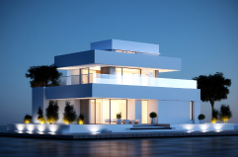By: Peter Kelly AGBEEHIA
What role does culture play in shaping our built environment? Does it seamlessly merge tradition with modernism, or does it translate tradition into modernism?
The way we design, and construct homes is not just about shelter—it is a reflection of who we are, our history, values, and way of life. In Ghana, cultural influences have long dictated housing structures, materials, and spatial arrangements.
However, with the rise of urbanization and globalization, modern construction is taking a new shape—often blending traditional concepts with contemporary designs or completely redefining them.
The deep connection between culture and housing
Housing is not just about four walls and a roof; it is a representation of identity. Different cultures perceive and experience space differently. According to anthropologist Edward Hall (1996), cultural backgrounds shape how individuals interpret and interact with their environment.
In Ghana, the concept of ‘home’ varies significantly across ethnic groups, each with distinct traditions influencing how houses are built and lived in.
Traditionally, Ghanaian homes were designed to suit communal lifestyles, with compound houses being the dominant housing type.
These structures typically feature a central courtyard surrounded by multiple rooms, accommodating extended families. The design supports social interaction, shared responsibilities, and a sense of unity.
In rural settings, homes were often built using locally sourced materials like mud, thatch, and wood—materials that were not only cost-effective but also environmentally sustainable.
The shift from traditional to modern housing
Over time, Ghana’s housing landscape has evolved significantly. The influence of Western architectural styles and economic growth has led to a shift from traditional compounds to single-family homes, townhouses in gated communities, and high-rise apartment complexes catering to an expanding middle class (Ndoum, 2018).
While this shift reflects development and modernization, it also raises questions about how much of Ghana’s rich cultural heritage is being preserved in contemporary housing designs.
Our very own Akans, provide a striking example of how culture influences architecture. Akan homes traditionally featured courtyard designs, open-air living spaces, and decorative symbols embedded into walls, reflecting their deep-rooted customs and spiritual beliefs.
However, in urban areas today, many of these cultural elements have been replaced with Western-style layouts that prioritize privacy and individualism over communal living.
How cultural influences can improve housing solutions
While modern housing in Ghana has largely followed Western blueprints, there is a growing realization that cultural influences can offer practical solutions to housing challenges such as affordability, sustainability, and community integration.
By understanding and embracing cultural diversity, developers and policymakers can create housing solutions that are not only functional but also resonate with the people who inhabit them.
- Sustainability through local materials: Traditional Ghanaian houses used earth-based materials like mud and bamboo, which are highly sustainable and well-suited for the local climate. Modern construction can incorporate these materials alongside contemporary innovations to create energy-efficient, eco-friendly homes.
- Community-oriented housing: Urban housing developments can take inspiration from the communal aspects of traditional compound houses, promoting shared spaces that foster social interactions while maximizing land use.
- Affordable housing solutions: By revisiting indigenous building techniques, construction costs can be reduced. Instead of relying heavily on imported materials, integrating locally sourced resources can make housing more accessible to the average Ghanaian.
Striking a balance – merging tradition with modernism
One of the critical questions in Ghana’s housing evolution is whether modernization should completely replace traditional architecture or if there is room for a fusion of both. The truth is, there is no need to erase tradition in the name of progress.
Rather, the best approach is to merge the two—creating designs that honor Ghana’s cultural identity while embracing modern advancements.
For example, while modern gated communities have become the preferred housing choice for the middle class, incorporating traditional elements such as inner courtyards, verandas, and natural ventilation can create a familiar and comfortable living environment.
Similarly, the practice of decorating homes with adinkra symbols or using local materials can keep Ghanaian heritage alive in modern developments.
The challenge of cultural erosion in modern housing
Despite the benefits of integrating cultural influences into housing, one of the biggest challenges facing Ghana’s construction industry is the rapid adoption of Westernized building styles that often disregard traditional ways of living.
Many modern luxury apartments and middle-income dwellings are designed with little consideration for Ghana’s climatic conditions and cultural norms (Nduom, 2018).
Furthermore, as globalization continues to influence lifestyles, younger generations may gradually lose appreciation for indigenous architecture. Without intentional efforts to preserve and incorporate Ghanaian cultural elements, the country risks losing a significant part of its architectural identity.
Conclusion – a way forward
As Ghana’s housing and construction industry continues to grow, it is crucial to acknowledge the profound role that culture plays in shaping the built environment. While modernization is inevitable, it should not come at the cost of cultural heritage.
By finding a middle ground—where tradition and innovation coexist—Ghana can create housing solutions that are sustainable, practical, and deeply connected to its identity.
Architects, urban planners, and developers must engage with local communities, learning from traditional practices while integrating contemporary advancements.
The future of housing in Ghana should not be an either-or choice between tradition and modernism, but rather a harmonious blend that reflects both the past and the future.
Our homes should tell our stories, honor our roots, and yet stand ready for the generations to come. Culture and construction are not separate entities—they are two sides of the same coin, shaping the way we live, interact, and define the very essence of home.
Source: Housing In Ghana Magazine
Housing in Ghana magazine is a publication under the Housing in Ghana Foundation, an organization that is committed to promoting and facilitating access to quality housing solutions across Ghana. The bi-annual magazine publication serves as a comprehensive guide for individuals, families investors as well as other key industry players seeking information on real estate trends and news, property listings and investment opportunities within the country. Email: [email protected] 0555444665 | 0599663344











